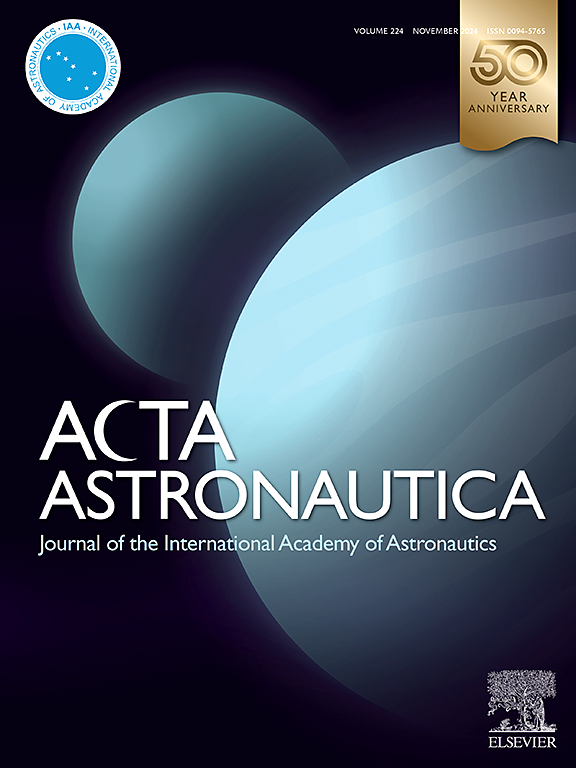Evolution of oxide composition, liquidus temperature, and viscosity during lunar molten regolith electrolysis
IF 3.1
2区 物理与天体物理
Q1 ENGINEERING, AEROSPACE
引用次数: 0
Abstract
The design and implementation of systems for molten lunar regolith electrolysis (MRE) benefit significantly from detailed modeling of the composition trajectory and evolution of composition-dependent thermophysical properties of regolith-derived oxides during this process. Two properties of interest are the liquidus temperature and viscosity of the molten oxide. The liquidus temperature evolution governs both the minimum reactor temperature and the extent of viable electrolysis at reasonably achievable reactor temperatures, while the viscosity is essential to the design of reactor outlet flow paths. This paper presents a strategy for modeling the oxide composition trajectory in MRE using the integrated thermochemical modeling software FactSage and calculating liquidus and viscosity evolution curves from the same software. This strategy was employed to model MRE of a lunar highlands regolith simulant composition. In contrast to previously employed modeling strategies, composition trajectory modeling in FactSage allows consideration of parallel species reduction during electrolysis, supporting detailed predictions of the compositions of reduced metallic products as a function of electrolysis reaction progress, which is quantified by the oxygen extraction yield parameter . For the regolith simulant composition modeled, it is suggested that a means of isolating ferrosilicon produced in the early stages of MRE from aluminum produced in more advanced stages should be implemented near = 0.30 to maintain the usability of each metallic product. The calculated liquidus temperature evolution from FactSage suggests a minimum reactor temperature requirement of 1675 °C, which allows electrolysis to progress to = 0.37, beyond which the liquidus rises above practical operating limits. Preliminary differential scanning calorimetry experiments indicate FactSage is more accurate than existing regression models at predicting liquidus evolution. The viscosity evolution predicted by FactSage is compared to the prediction of five models from the literature. Spindle viscometry experiments on select compositions indicate that FactSage outperforms all the literature models at least for ≤ 0.165, demonstrating agreement to within 28 % between 1300 and 1600 °C for this composition range, which is attributed to its incorporation of a quasichemical model for bridging oxygen concentration in silicate melts. The advantages of using this model diminish for compositions beyond = 0.30, which only contain small concentrations of SiO2. The accuracy of viscosity models for these late-stage compositions may depend primarily on the distribution of compositions within the SiO2-CaO-Al2O3 ternary system sampled to calculate empirical parameters.
月球熔融风化层电解过程中氧化物组成、液相温度和粘度的演变
熔融月球风化层电解(MRE)系统的设计和实现得益于详细的组成轨迹建模和风化层衍生氧化物在这一过程中与组成相关的热物理性质的演变。我们感兴趣的两个性质是熔融氧化物的液相温度和粘度。液相温度的演变决定了反应器的最低温度和在合理可达到的反应器温度下可行电解的程度,而粘度对反应器出口流道的设计至关重要。本文提出了一种利用集成热化学建模软件FactSage对MRE中氧化物组成轨迹进行建模的策略,并利用该软件计算液相和粘度演化曲线。这一策略被用于模拟月球高原风化层模拟成分的MRE。与之前采用的建模策略相比,FactSage中的成分轨迹建模允许考虑电解过程中的平行物质还原,支持对还原金属产物的成分作为电解反应过程的函数的详细预测,这是通过氧萃取率参数λO2量化的。对于模拟的风土组成,建议在λO2 = 0.30附近将MRE早期生产的硅铁与后期生产的铝分离,以保持每种金属产品的可用性。FactSage计算的液相温度演变表明,反应器温度最低要求为1675°C,这允许电解进展到λO2 = 0.37,超过该温度,液相上升到实际操作极限以上。初步差示扫描量热实验表明,FactSage在预测液相演化方面比现有的回归模型更准确。FactSage预测的粘度演变与文献中五个模型的预测进行了比较。对所选组分的主轴粘度实验表明,FactSage至少在λO2≤0.165的范围内优于所有文献模型,在1300 ~ 1600°C范围内的一致性在28%以内,这归因于它结合了硅酸盐熔体中桥接氧浓度的准化学模型。当组分大于λO2 = 0.30,且仅含少量SiO2时,使用该模型的优势减弱。这些后期组分的粘度模型的准确性可能主要取决于用于计算经验参数的SiO2-CaO-Al2O3三元体系中组分的分布。
本文章由计算机程序翻译,如有差异,请以英文原文为准。
求助全文
约1分钟内获得全文
求助全文
来源期刊

Acta Astronautica
工程技术-工程:宇航
CiteScore
7.20
自引率
22.90%
发文量
599
审稿时长
53 days
期刊介绍:
Acta Astronautica is sponsored by the International Academy of Astronautics. Content is based on original contributions in all fields of basic, engineering, life and social space sciences and of space technology related to:
The peaceful scientific exploration of space,
Its exploitation for human welfare and progress,
Conception, design, development and operation of space-borne and Earth-based systems,
In addition to regular issues, the journal publishes selected proceedings of the annual International Astronautical Congress (IAC), transactions of the IAA and special issues on topics of current interest, such as microgravity, space station technology, geostationary orbits, and space economics. Other subject areas include satellite technology, space transportation and communications, space energy, power and propulsion, astrodynamics, extraterrestrial intelligence and Earth observations.
 求助内容:
求助内容: 应助结果提醒方式:
应助结果提醒方式:


